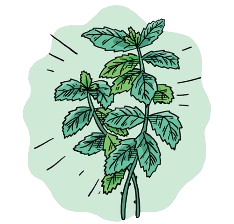Learn to grow microgreens at home, join Grow It Local +
How to grow
Join Our Community
Learn to grow and cook healthy, delicious, organic food at home by joining our seasonal grow-alongs.
Join Our Community
Learn to grow and cook healthy, delicious, organic food at home by joining our seasonal grow-alongs.
Growing Tips and Tricks
Location:
Spearmint thrives in a sunny to partially shaded location. It prefers well-draining soil with a slightly acidic to neutral pH level, typically between 6.0 to 7.0. It is a hardy herb that can tolerate a range of growing conditions but prefers a spot with at least 4-6 hours of sunlight per day.
Watering:
Spearmint appreciates consistently moist soil. Water the plant regularly to keep the soil evenly moist but not waterlogged. Aim to water deeply at the base of the plant whenever the top layer of soil feels dry. In hot weather, you may need to water more frequently.
Problems:
Invasive Growth: Spearmint has a vigorous growth habit and can spread rapidly. It is recommended to grow spearmint in containers or use barriers like buried pots to prevent it from taking over your garden.
Pests: Keep an eye out for common herb pests such as aphids and spider mites. Treat any infestations with neem oil
Diseases: Spearmint is generally resistant to diseases, but overly wet conditions can lead to root rot. Ensure the soil has good drainage to prevent this problem.
Harvest:
You can start harvesting spearmint once the plant has grown to a sufficient size. Avoid harvesting more than one-third of the plant at a time, as this ensures the plant remains healthy and continues to grow. To harvest, simply snip off the stems just above a leaf node to encourage branching and bushier growth.
Background
Originally native to Europe and parts of Asia, spearmint was well-known in ancient times. The ancient Greeks and Romans appreciated its aromatic properties and used it for culinary and medicinal purposes. Its name, ‘spearmint,’ is derived from the pointed, spear-like shape of its leaves.
Spearmint’s popularity as a medicinal herb continued into the Middle Ages, where it was believed to have various healing properties and was used to treat a range of ailments, including indigestion and headaches.
As trade routes expanded, spearmint found its way to other parts of the world. It was introduced to the Americas by early European settlers, and it quickly adapted and thrived in the new environments.
In the 18th and 19th centuries, spearmint gained significant commercial importance, particularly in Europe and the United States, where it was cultivated for its essential oil, widely used in the production of flavourings, candies, and oral care products.
Health Benefits
Eating homegrown, organic spearmint is good for you!
It is rich in antioxidants, vitamins (A and C), and minerals (iron and manganese). Eating spearmint may aid digestion and alleviate indigestion and bloating. Its menthol content provides a cooling effect, relieving headaches and sinus congestion. Spearmint possesses antimicrobial properties that may help combat certain bacteria and fungi. Additionally, it can promote relaxation and reduce stress and anxiety. The antioxidants in spearmint contribute to overall health and may support healthy skin
Patch to plate
Not to be confused with it’s close relative peppermint, or any other members of the mint family for that matter, spearmint has a light, delicately sweet flavour that’s perfect for cooking. Spearmint is generally used for savoury dished and pepper mint in sweet dishes. Here’s some aromatic inspiration to get the most out of your spearmint patch:
- To make a delicious, homemade mint sauce to serve alongside roast lamb
- As a garnish to a refreshing mojito
- Crushed up and served in boiling water as a simple and refreshing homemade tea
- Thinly sliced and served up with crushed peas and butter.




